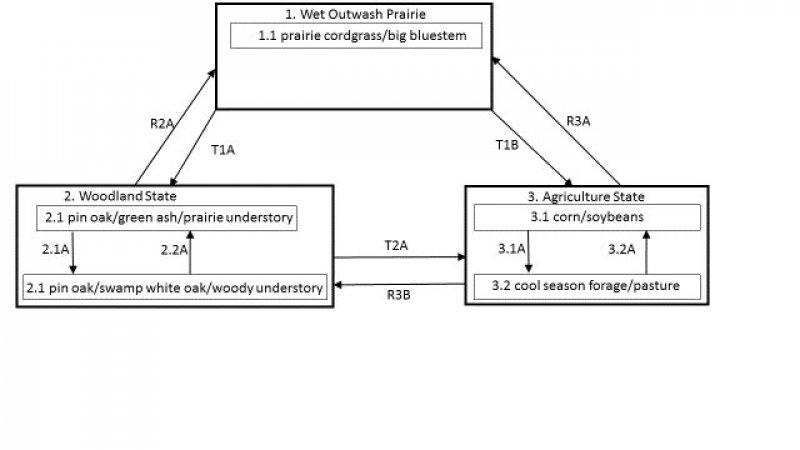
Natural Resources
Conservation Service
Ecological site R111XB401IN
Wet Outwash Mollisol
Last updated: 9/11/2024
Accessed: 04/29/2025
General information
Provisional. A provisional ecological site description has undergone quality control and quality assurance review. It contains a working state and transition model and enough information to identify the ecological site.
MLRA notes
Major Land Resource Area (MLRA): 111X–Indiana and Ohio Till Plain
111B – Indiana and Ohio Till Plain, Northeastern Part. This area is in the Eastern Lake and Till Plains Sections of the Central Lowland Province of the Interior Plains. The entire MLRA is glaciated, and most areas are dominated by ground moraines that are broken in places by lake plains, outwash plains, flood plains, and many recessional moraines. The ground moraines and lake plains in front of the recessional moraines are flat to undulating. In many places stream valleys occur at the leading edge of the recessional moraines. Narrow, shallow valleys commonly are along the major rivers and streams in this MLRA, and some areas along the major rivers and streams have deposits of sand. Elevation ranges from 630 to 1,550 feet (190 to 470 meters), increasing gradually from west to east. Relief is mainly a few meters, but in some areas hills rise as much as 100 feet (30 meters) above the adjoining plains.
The extent of the major Hydrologic Unit Areas (identified by four-digit numbers) that make up this MLRA is as follows: Western Lake Erie (0410), 41 percent; Wabash (0512), 28 percent; Scioto (0, 28 percent; Scioto (0506), 10 percent; St. Clair-Detroit (0409), 9 percent; Great Miami (0508), 6 percent; Southeastern Lake Michigan (0405), 5 percent; and Southwestern Lake Huron (0408), 1 percent. The Huron River in Michigan, Cedar Creek in Indiana, and the Sandusky River in Ohio have been designated as National Wild and Scenic Rivers in this MLRA.
The surficial materials in this area include glacial deposits of till, outwash, and lacustrine sediments from Wisconsin and older glacial periods. A thin mantle of loess occurs in some areas. Most of the MLRA is underlain by Silurian and Devonian limestone and dolostone. Middle Devonian to Early Mississippian black shale and Early to Middle Mississippian siltstone and shale are in some areas of the northern part of the MLRA.
Classification relationships
Major Land Resource Area (USDA-Natural Resources Conservation Service, 2006)
USFS Ecological Regions (USDA, 2007):
Sections –Central Till Plains, Beech Maple (222H), South Central Great Lakes (222J)
Subsections – Bluffton Till Plains (222Ha), Bluffton-Ann Arbor Till Plains (222Je), Jackson Interlobate Moraine (222Jg), Steuben Interlobate Moraines (222Ji)
NatureServe Systems anticipated (NatureServe, 2011): Agriculture - Cultivated Crops and Irrigated Agriculture, Agriculture – Pasture/Hay, North-Central Interior Beech-Maple Forest, North-Central Interior Dry-Mesic Oak Forest and Woodland, North-Central Interior Floodplain
LANDFIRE Biophysical Settings anticipated (USGS, 2010): Central Interior and Appalachian Floodplain Systems, North-Central Interior Beech-Maple Forest, North-Central Interior Dry-Mesic Oak Forest and Woodland
Ecological site concept
This site is an upland site formed on glacial outwash parent materials in soils that are very poorly or poorly drained and in the aquic taxonomic suborder. The soils surface color is dark (3/2 Munsell or darker) and extends beyond 10 inches, making them taxonomically mollisols. This site is found on flat portions (slope 0-2%) on outwash plains and terraces. Similarly, ponding of water to a depth of 15 inches occurs frequently for a duration that can exceed 30 days.
The characteristic vegetation of this site is of a tall-grass prairie that is dominated by prairie cordgrass, big bluestem, and a variety of sedge species. The combination of accumulation of organic material and seasonal changes in water which led to an increased probability of fire limited the encroachment of woody species. Fires occurred on this site every 5 years or less with the ignitions being a mix of lightning strikes and those set by Native Americans. During the dormant season, these fires were less frequent and of lower intensity and size than those that occurred during the growing season. Grazing by ungulates had an effect on the production and species diversity of this site, but the magnitude of the impact was less than that for prairies farther west. Reduction, or in most cases elimination, of fire as converted the site that of a woodland or forest dominated primarily by oak and hickory species. The understory would contain many of the prairie species until the canopy closed. Woody understory species would include sassafras, some willows, and dogwood species. Currently, most of this site is in agricultural production, with the majority being used to raise corn and soybeans after the installation of drainage, followed by tillage, and management.
Associated sites
| R111XB402IN |
Dry Outwash Integrade Dry Outwash Integrade. Soils not in aquic taxonomic suborder and are somewhat poorly drained or drier. |
|---|---|
| F111XB403IN |
Outwash Upland Outwash Upland. Soil surface is light in color (lighter than 3/2 Munsell) |
| F111XB404IN |
Dry Outwash Upland Dry Outwash Upland. Soil surface is light in color (lighter than 3/2 Munsell) and are moderately well drained or drier. |
Similar sites
| R111XB402IN |
Dry Outwash Integrade Dry Outwash Integrade |
|---|---|
| R111XB301IN |
Dark Bedrock Prairie Dark Bedrock Prairie |
Table 1. Dominant plant species
| Tree |
Not specified |
|---|---|
| Shrub |
Not specified |
| Herbaceous |
(1) Spartina pectinata |
Click on box and path labels to scroll to the respective text.



